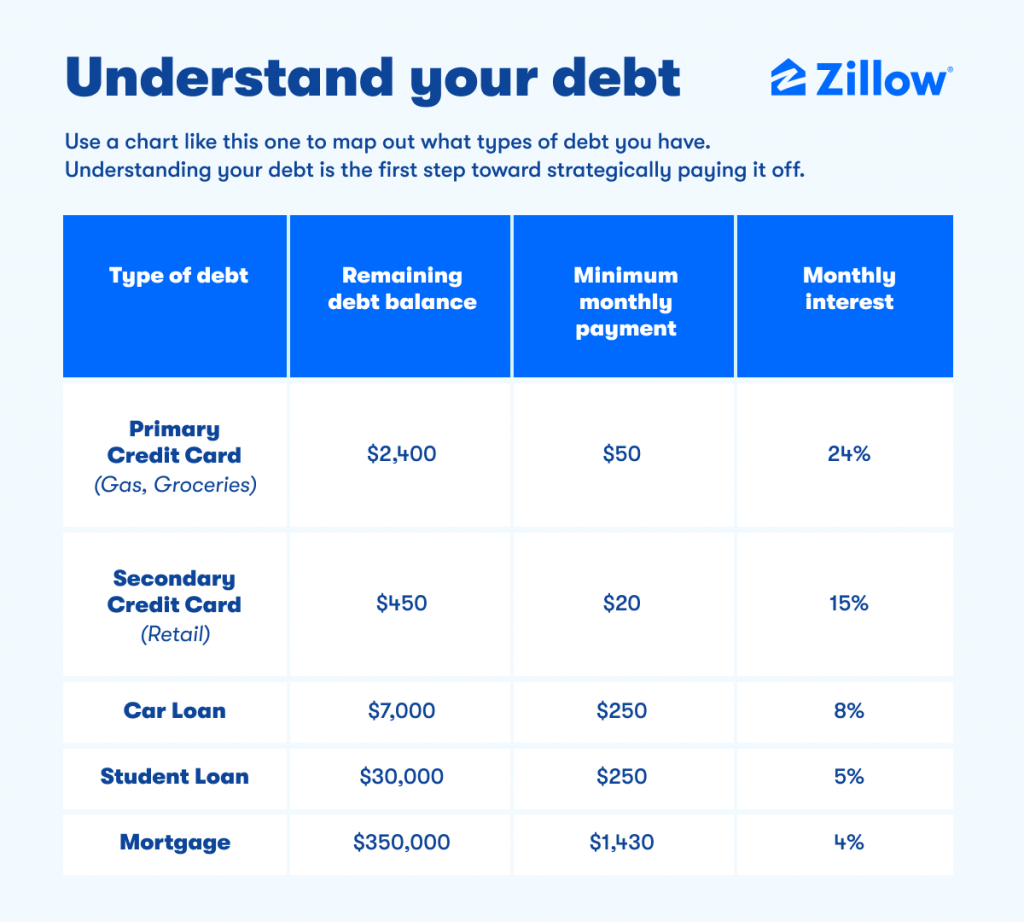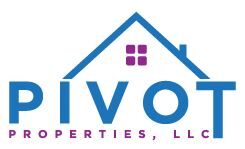
Debt is money that you borrowed and are obligated to repay. Examples of debt include mortgages, student loans, auto loans and credit cards.
Zillow research found that 69% of renters have some type of debt, and a quarter of renters said they were denied a rental agreement or home financing due to their debt level. Debt impacts not only the type of home you can rent or buy but also your timeline for buying, your ability to afford an adequate down payment, and whether you’ll be approved for a mortgage. Paying off debt may help you qualify for a mortgage by improving your debt-to-income (DTI) ratio.
Here are some suggested strategies for managing your debt. Keep in mind, every situation is different and you may want to seek professional advice relating to your individual financial needs and goals.
1. Understand your debt
“Good debt” supports your goals. “Bad debt” doesn’t. For example, a mortgage could enable you to buy a home and create equity in it. On the other hand, credit-card debt could fuel spending for products or services you may not need — or even really want. The first step toward paying off debt fast is figuring out the types of debt you have and the amount you owe. List all your debts, including your unpaid balance, annual percentage rate (APR) and monthly minimum payment for each, like in this example table:

Unsure of your total debt? You can access free copies of your credit report once every 12 months from the three major credit bureaus online through AnnualCreditReport.com, a site authorized by the Federal Trade Commission. Your credit report and credit scores give prospective lenders a snapshot of how much, and how well you manage, debt.
2. Adjust your spending habits
The second step to paying off debt fast is to figure out how much you can pay toward your debt each month. Start by keeping track of all your expenses and sorting them into “essentials” and “nonessentials.” Brainstorm how to stop spending on nonessentials and spend less on essentials. For example, you may be able to trim your grocery bill by using manufacturers’ coupons, buying generic goods, or planning menus around store specials. However you adjust your spending habits, be sure to create a budget to allocate as much as you can toward paying off your debt.
3. Create a debt repayment plan
Your approach will depend in part on how soon you want to pay off your debt, how much debt you have, and how much you’ve budgeted for repayment. The more you budget for this purpose, the faster you can meet your goal. Watch this video to learn different ways to pay off debt quickly:https://www.youtube.com/embed/eQJEyO–PBk?feature=oembed&enablejsapi=1&modestbranding=1&rel=0&showinfo=0
Pay off your lowest balance
This strategy, known as the “snowball method,” can create quick wins that could motivate you to continue to pay off debt. This can be good for anyone who is looking for a simple way to pay down debt and see gains quickly. Once you have that first piece of debt paid off, you can put that debt payment toward your next piece of debt, increasing the payment as your total debt shrinks.
Pay off your highest interest debt
When that’s done, pay off your next-highest APR debt. This approach, known as the “avalanche method,” can lower your interest expense so you can pay off debt faster. Once the highest APR debt is paid off, use the same approach as the snowball method, and put that debt payment amount toward your next highest APR debt to pay down your debt faster.
Pay off your highest stress debt
Instead of focusing on the dollar amount or APR, pay off the debt that causes you the most stress first. It can be a loan from a friend or family member or a bank you’ve had a terrible time with. You may feel that much freer just by getting this debt out of your life for good.
Transfer your balance
Balance transfer cards with low or zero-percent interest can help you pay off credit card debt faster, but these cards may involve fees, and your rate typically is much higher after your promotional period ends. If you don’t pay off the debt before the promo period is over, you’ll risk paying a higher interest rate on the entire original amount.
4. Make payments on-time
Late payments can trigger higher rates and late-payment fees. To avoid those penalties, be sure you make your payments on time or even a day or two early. On-time payments may also improve your credit scores, which could help you access new loan options at more attractive rates. Setting up automated bill payment reminders or using an online bill payment service may help you make payments on time. (Check with your bank or credit union as many offer this service.)
5. Pay more than the minimum
Minimum payments often aren’t enough to pay all the interest you owe, plus part of your outstanding balance. Consequently, if you pay only the minimum, it likely will take longer to pay off the balance. Paying more than the minimum each month should help you pay the debt off more quickly.
6. Make multiple payments a month
Making more than one payment toward the same debt each month can help you pay off your debt faster. It can help you avoid late fees and reduces the overall amount you pay in interest every month. Most credit card companies will only let you set up one monthly auto-pay, but you can make additional online payments throughout the month.
7. Build a savings
Financial emergencies can derail even the best intentions to pay off debt. In fact, Zillow’s data shows 38% of renters cannot afford a $1,000 emergency. To avoid this situation, try to stash some of your income each month in a savings account at a bank or credit union while you stay on track with repaying your debt. Even a relatively small amount of savings can add up over time. Setting up automatic transfers can help you boost your savings, but be careful not to overdraw your checking account.
8. Track your debt payoff progress
Paying off debt can feel highly satisfying. It can also motivate you to continue paying off even more debt. To capture those positive feelings, keep track of how much debt you’ve paid off as well as how much you still owe. Visualize and appreciate your success with a spreadsheet or graph — you can find free charts online that let you color in sections as you pay off specific dollar amounts.
Need support to manage your debt?
Paying off debt isn’t always easy, but there are resources that may help you keep track of your debt payoff or debt relief and boost your motivation to keep going.
Debt management apps
There are numerous apps that can help you budget for, manage and repay your debt. Look for apps that fit your specific goals; consider a tool like Mint for support with general budgeting and bill payment tracking, Tally for support in paying off credit card debt, or an app like Digit, that automatically transfers savings from your checking account that you can use to repay debts.
Of course, you don’t need to use an app if you’d prefer not to. A simple spreadsheet or Word document, or an old-fashioned notebook, green-bar paper or paper budget planner and pencil may work just as well and save you up to $60 a year.
Debt relief programs
A debt relief agency may be able to help you create a plan to pay off your debt. The federal Consumer Financial Protection Bureau provides the following resources:
Credit counseling: How to choose a credit counselor and questions to ask before you get started.
Debt settlement programs: Advice for coping with debt and understanding your options.
Debt consolidation: Important facts you should know before contacting a debt settlement company.
Mortgage assistance options: Information about federal mortgage debt relief programs during the COVID-19 pandemic.
Student loan relief: Information about federal student loan assistance during the COVID-19 pandemic.
If you’re trying to save for a house, paying off your debt is a great first step. Read our article on How to Save for a House to learn more and consider checking if your current debt-to-income ratio qualifies then reach out to a pre-qualifying lender to start the mortgage pre-qualification process.

